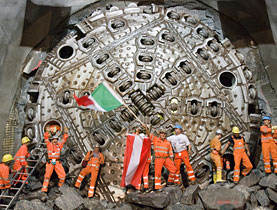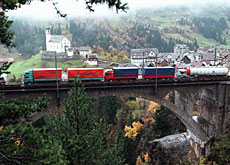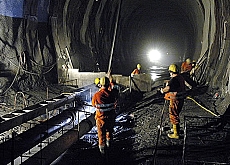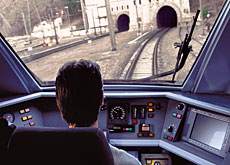Saint keeps watch as miners keep tunnelling

Switzerland is riddled with tunnels like a cheese. These tunnels are vital for the country's development but building them is expensive and dangerous even today.
December 4 is the day dedicated to St Barbara, the patron saint of miners. Tunnel builders still ask her to watch over them. Her statue stands at the entrance of every tunnel site, and the workers mark her feast day with a special church service.
Tunnel building has a long history in Switzerland. This year saw the 300th anniversary of the first tunnel built in the Alps. By modern standards it was nothing spectacular: the Urnerloch by Andermatt was only 64 metre long, two metres wide and 2.5 metres high.
But it provided a much safer and more reliable way to the vital Gotthard pass than the old bridge it replaced, which consisted of planks attached to the cliff face by chains, and which was often swept away.
Modest as it was, it had several things in common with subsequent tunnels. In the first place, it was part of Switzerland’s constant improvement of the routes linking it with Italy, a forerunner of much deeper tunnels like those under the Gotthard, Simplon and Great St Bernard.
It was greatly admired, and became a tourist attraction in itself. It laid the foundations of Switzerland’s reputation as a tunnel-building nation.
On the negative side, like many subsequent tunnels, it suffered a cost overrun – although the engineer, Pietro Morettini, was not held to blame. Indeed, he was widely praised for completing the contract well ahead of schedule, something not always achieved today.
And two of the workers died during construction, the first in a long line of casualties.
Safety
Accidents have always overshadowed tunnelling work: 2008 was also the 100th anniversary of one of the worst disasters in Swiss tunnel building history: 25 men died when a shaft collapsed in the first Lötschberg rail tunnel, which links canton Bern with the Rhone valley. Their bodies were never recovered and the route had to be altered.
The geological survey had missed a vital problem – and even today miners can have unpleasant surprises. Geologists have far better tools and greater knowledge, but surveying still has to find a balance between taking sufficient samples and keeping costs within acceptable limits.
In 2005, workers on the new 57 km Gotthard base tunnel (GBT) hit an unexpected patch of powdery gravel which cascaded into the huge boring machine. It took five months to get it free. Earlier the same year, the ground suddenly collapsed under a shopping centre during excavation of the M2 metro line in Lausanne.
“You have to sleep, because you need energy to work the next day, but if you start thinking too much, you won’t sleep at all,” one of the M2 engineers told Swiss radio, describing the hazards of his job.
The Lötschberg disaster was not the first accident, or the worst. In 1857 fire broke out in the Hauenstein tunnel on the important line south from Basel, and 64 workers died. In all 177 were killed during the construction of the first Gotthard line (1872-82). The breakthrough on the Simplon in 1905 was overshadowed by the death of two engineers, killed by poisonous gas released at the moment of triumph.
Today safety is at a premium: fluorescent clothing, helmets, emergency oxygen equipment and smoke-proof escape containers are taken for granted. Everyone entering the construction site of the GBT is checked in and out. But it’s tough work, in difficult conditions. Seven workers have died since construction started in 2002.
Equipment
It’s a far cry from Morettini’s picks and black powder to today’s huge tunnel boring machines, or TBMs.
Machines, driven by compressed air or pressurised water, speeded up work dramatically when they were introduced in the middle of the 19th century to drill holes in the rock for the explosive charge.
The Gotthard used dynamite for the first time – a much faster process than black powder, but damaging to the miners’ lungs. Efficient TBMs only came into their own in the mid-20th century: they have a rotating head with cutters and create a hole as big as themselves – 9.5 metres in diameter in the GBT.
Years of experience, both in Switzerland and abroad, enable engineers to decide what kind of machine is best for the specific circumstances. In the Lötschberg base tunnel – 34.6 km long, opened in 2007 – 80 per cent was blasted, and 20 per cent bored.
The Gotthard is being built mainly with TBMs, which, with a length of 440 m, resemble a construction site in themselves – except that when the head moves forward, biting into the rock, the whole site follows.
“It’s like a millipede,” Maurus Huwiler of AlpTransit Gotthard, the company overseeing the tunnel construction, told swissinfo.
Only about 25 people are needed per shift. Steering the machine is a skilled job, done from a cabin with a bank of screens; most of the other miners are involved in the logistics of getting the right equipment to the right place at the right time. Teamwork is vital, Huwiler explained.
Foreign labour
The teams are tightly knit; they often come from the same village and are friends or even members of the same family. An Austrian company got the contract for the stretch of tunnel at the northern entrance, so unsurprisingly, many of the teams there are Austrian, others German.
It is nothing new for the miners not to be Swiss. Traditionally it was Italians who provided the muscle. But the men who built the first Gotthard tunnel would be amazed to see how their successors live.
The first miners had to put up with appalling living conditions, in housing that was desperately overcrowded – and overpriced. “Some of the accommodation was like pig sties; in one house human excrement was flowing down the outside walls,” wrote Laurenz Sonderegger, a tireless campaigner for public health, after a visit to Göschenen.
Today’s workers live in specially built, neat, prefabricated blocks. In videos displayed at the Gotthard information centre, several say how much they appreciate being in Switzerland.
But they are all part of the same chain. And without them, Switzerland would be a different place.
swissinfo, Julia Slater
The alpine passes have always been an important transit route between Switzerland and Italy.
The opening up of the Gotthard pass in the 13th century was a key event in Swiss history.
The construction of Switzerland’s first alpine tunnel, the Urnerloch, in 1708, made the Gotthard safer.
The development of the railways in the second half of the 19th century led to a boom in tunnel construction.
The first railway tunnel was the 90m long Schlossberg tunnel near Baden in northern Switzerland.
The most important was the first Gotthard rail tunnel, built from 1871 to 1881.
Other major tunnels were the Simplon (completed 1906) and the Lötschberg (completed 1913).
After the First World War hundreds of kilometres of tunnels were excavated for hydroelectric power stations.
The period after the Second World War saw a number of road tunnels, including the Gotthard, completed in 1980, which for 20 years was the longest in the world.
As part of Switzerland’s New Railway Links through the Alps (NRLA), a second Lötschberg tunnel opened in 2007, and a new Gotthard tunnel is under construction. Both of these are much deeper than their predecessors, so trains do not have to climb to reach them, and can thus be longer and faster.
Much of the workforce to build the tunnels has come from abroad; traditionally many of the labourers were Italians.

In compliance with the JTI standards
More: SWI swissinfo.ch certified by the Journalism Trust Initiative




You can find an overview of ongoing debates with our journalists here . Please join us!
If you want to start a conversation about a topic raised in this article or want to report factual errors, email us at english@swissinfo.ch.